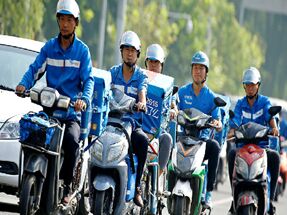外媒:电子商务带来便利 快递交通安全等问题也不容忽视
|
Digital commerce is exacting a very analog toll on the streets of Shanghai. According to the city's Information Office, there were 325 traffic accidents -- and five deaths -- involving delivery drivers during the first half of 2019. China is the world's biggest e-commerce market and more than 80% of those drivers were dropping off packages and meals for services such as Meituan Dianping and Alibaba Group Holding Ltd.'s Ele.Me. It's a sign of how fast the market is expanding: For the whole of 2017, there were only 117 delivery-related accidents in the city.
Shanghai's data highlights a global problem: Cities are uNPRepared to absorb the physical impact of e-commerce. For now, most problems don't yet rise above the level of annoyances. But the risks will grow quickly if developers and municipal leaders don't start to account for e-commerce when developing urban regulations and infrastructure. As with many technological innovations, early boosters of e-commerce championed its environmental virtues. Digital shopping was portrayed as a healthier way to consume. Grouped deliveries would replace the individual trip to the shop, thereby reducing traffic and carbon emissions. Fewer brick-and-mortar stores, especially in suburban locations, would allow for more productive and sustainable uses of space, including by health care facilities and parks. The industry has grown exponentially since those early days, however. Between 2009 and 2018, the number of parcels delivered by the US Postal Service doubled to 6.2 billion annually. The mountains of cardboard in apartment trash rooms are proof: In New York, roughly four in 10 residents receive at least one delivery per week. And many packages are sent to offices rather than homes, during peak business hours. In Germany, freight transportation accounts for only 30% of all traffic but 80% of peak-hour inner-city traffic. In London, where congestion charges have reduced the number of private cars on the road during the day, delivery vans and ride-hailing services such as Uber have more than made up the difference. Researchers in Seattle found that roughly half of the trucks making deliveries downtown parked illegally, blocking and slowing other traffic. Then there's China, where just one food-delivery company -- Meituan -- employs 600,000 drivers to serve 400 million customers annually in 2,800 cities. Drivers mostly use electrified two-wheelers that swerve through traffic and along sidewalks, and park pretty much wherever a delivery is to be made. The swarm of e-bikes clogging sidewalks has even prompted irate columns in media outlets that ordinarily cheer on China's e-commerce champions. The problem is only going to get worse. In Seattle, home of Amazon.com Inc., a compound annual e-commerce growth rate of 20% between 2018 and 2023 is expected to more than double goods deliveries. The numbers for China are even more staggering: Online retail sales are projected to grow by 30% in 2019 and reach nearly $2 trillion, accounting for more than half of all global online retail sales. There are no easy fixes. Ticketing or towing delivery trucks for parking in bike lanes and blocking roads is emotionally satisfying for those inconvenienced, but will only address symptoms rather than underlying causes. To do that will require far more creative partnerships between cities, e-commerce companies and housing owners and developers. For instance, New York and other cities have demonstrated that providing incentives for off-peak deliveries (or forbidding peak-hour ones) can help reduce urban congestion. More bike lanes and parking spots would cut down on accidents and traffic in developing-world cities such as Shanghai. Municipal governments should consider requiring new multi-unit developments to include space for delivery parking. They could work with e-commerce companies to set up lockers near transit hubs in order to reduce the number of delivery stops. Long-term, companies could look for opportunities to partner with one another on deliveries and consolidate individual shipments. Finally, public education campaigns could better inform consumers about the impact of e-commerce on the shared urban environment. More than a few customers might choose to forgo some individual convenience for a safer and less chaotic city. |









